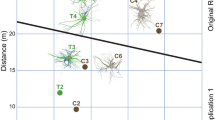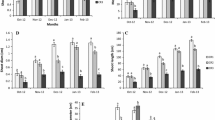Abstract
The Wollemi pine was discovered in 1994 at the base of a deep rainforest canyon in the Wollemi National Park, southeastern Australia. Only three populations have been found, comprising less than 100 adult trees. Ex situ conservation collections were quickly established, and also a commercial propagation program to produce plants for horticulture. We investigated vegetative propagation methods, focussing on rooting of cuttings with different amounts of foliar pruning, irradiance or fertiliser application, and we compared anatomy and rooting of cuttings at two different stages of stem development. We related root production to levels of photoinhibition experienced during the propagation phase, quantifying photoinhibition by measuring chlorophyll fluorescence. Maximum photochemical efficiency (FV/FM) of cuttings declined during daily stress periods, particularly after many weeks without roots in the propagation environment, but these declines did not inhibit root formation. Mean percentage of cuttings that formed roots was usually high (79.4–94.0%). Treatments that alleviated photoinhibition, such as low irradiance or foliar fertilisation, did not increase rooting percentages. Other treatments that did not alleviate photoinhibition, such as incorporation of fertiliser in the medium or no pruning, did accelerate formation of an extensive root system. Soft cuttings had a less-developed sclerenchyma ring in their cortex compared with firm cuttings, but both cutting types provided high rooting percentages. Our results showed that cuttings under mist irrigation can be prone to long periods of moderate photoinhibition and yet remain highly capable of root production.








Similar content being viewed by others
References
Adams WW III, Demmig-Adams B (1994) Carotenoid composition and down regulation of photosystem II in three conifer species during the winter. Physiol Plant 92:451–458
Aminah H, Dick JMcP, Grace J (1997a) Influence of irradiance on water relations and carbon flux during rooting of Shorea leprosula leafy stem cuttings. Tree Physiol 17:445–452
Aminah H, Dick JMcP, Grace J (1997b) Rooting of Shorea leprosula stem cuttings decreases with increasing leaf area. For Ecol Manage 91:247–254
Balachandran S, Osmond CB (1994) Susceptibility of tobacco leaves to photoinhibition following infection with two strains of tobacco mosaic virus under different light and nitrogen nutrition regimes. Plant Physiol 104:1051–1057
Binder WD, Fielder P, Mohammed GH, L’Hirondelle SJ (1997) Applications of chlorophyll fluorescence for stock quality assessment with different types of fluorometers. New For 13:63–89
Blaikie SJ, Chacko EK (1998) Sap flow, leaf gas exchange and chlorophyll fluorescence of container-grown cashew (Anacardium occidentale L.) trees subjected to repeated cycles of soil drying. Aust J Exp Agric 38:305–311
Blazich FE (1988) Mineral nutrition and adventitious rooting. In: Davis TD, Haissig BE, Sankhla N (eds) Adventitious root formation in cuttings. Dioscorides Press, Portland, OR, pp 61–69
Bruce SE, Rowe DB, Flore JA (2001) Chlorophyll fluorescence and vegetative propagation of Taxus. Hortscience 36:971–975
Cameron RWF, Harrison-Murray RS, van Campfort K, Kesters K, Knight LJ (2001) The influence of branches and leaf area on rooting and development of Cotinus coggygria cv. Royal Purple cuttings. Ann Appl Biol 139:155–164
Chambers TC, Drinnan AN, McLoughlin S (1998) Some morphological features of Wollemi pine (Wollemia nobilis: Araucariaceae) and their comparison to Cretaceous plant fossils. Int J Plant Sci 159:160–171
Close DC, Beadle CL, Hovenden MJ (2001) Cold-induced photoinhibition and foliar pigment dynamics of Eucalyptus nitens seedlings during establishment. Aust J Plant Physiol 28:1133–1141
Dawson IA, King RW (1994) Propagation of some woody Australian plants from cuttings. Aust J Exp Agric 34:1225–1231
Fensom G, Offord C (1997) Propagation of the Wollemi pine. Comb Proc Int Plant Prop Soc 47:66–67
Fernandes J, Chaloub RM, Reinert F (2002) Influence of nitrogen supply on the photoprotective response of Neoregelia cruenta under high and low light intensity. Funct Plant Biol 29:757–762
Grange RI, Loach K (1983) The water economy of unrooted leafy cuttings. J Hortic Sci 58:9–17
Hartmann HT, Kester DE, Davies FT, Geneve RL (1997) Plant propagation: principles and practices. Prentice-Hall, Upper Saddle River, NJ, 770 pp
Hill K (1996) The Wollemi pine: discovering a living fossil. Nat Resour 32:20–25
Hill RS, Brodribb TJ (1999) Southern conifers in time and space. Aust J Bot 47:639–696
Jones WG, Hill KD, Allen JM (1995) Wollemia nobilis, a new living Australian genus and species in the Araucariaceae. Telopea 6:173–176
Leakey RRB, Coutts MP (1989) The dynamics of rooting in Triplochiton scleroxylon cuttings: their relation to leaf area, node position, dry weight accumulation, leaf water potential and carbohydrate composition. Tree Physiol 5:135–146
Leakey RRB, Newton AC, Dick JMcP (1994) Capture of genetic variation by vegetative propagation: processes determining success. In: Leakey RRB, Newton AC (eds) Tropical trees: potential for domestication, rebuilding genetic resources. HMSO, London, UK, pp 72–83
Lebude AV, Goldfarb B, Blazich FA, Wise FC, Frampton J (2004) Mist, substrate water potential and cutting water potential influence rooting of stem cuttings of loblolly pine. Tree Physiol 24:823–831
Marler TE, Lawton PD (1994) Error in interpreting field chlorophyll fluorescence measurements: heat gain from solar radiation. Hortscience 29:1172–1174
Maxwell K, Johnson GN (2000) Chlorophyll fluorescence—a practical guide. J Exp Bot 51:659–668
Mesén F, Newton AC, Leakey RRB (1997) The effects of propagation environment and foliar area on the rooting physiology of Cordia alliodora (Ruiz & Pavon) Oken cuttings. Trees 11:404–411
Mesén F, Leakey RRB, Newton AC (2001) The influence of stockplant environment on morphology, physiology and rooting of leafy stem cuttings of Albizia guachapele. New For 22:213–227
Mohammed GH, Binder WD, Gillies SL (1995) Chlorophyll fluorescence: a review of its practical forestry applications and instrumentation. Scand J For Res 10:383-410
Murthy R, Goldfarb B (2001) Effect of handling and water stress on water status and rooting of loblolly pine stem cuttings. New For 21:217–230
Nketiah T, Newton AC, Leakey RRB (1998) Vegetative propagation of Triplochiton scleroxylon K. Schum in Ghana. For Ecol Manage 105:99–105
Offord CA, Meagher PF (2001) Effects of temperature, light and stratification on seed germination of Wollemi pine (Wollemia nobilis, Araucariaceae). Aust J Bot 49:699–704
Offord CA, Porter CL, Meagher PF, Errington G (1999) Sexual reproduction and early plant growth of the Wollemi pine (Wollemia nobilis), a rare and threatened Australian conifer. Ann Bot 84:1–9
Ofori DA, Newton AC, Leakey RRB, Grace J (1996) Vegetative propagation of Milicia excelsa by leafy stem cuttings: effects of auxin concentration, leaf area and rooting medium. For Ecol Manage 84:39–48
Ögren E (1990) Evaluation of chlorophyll fluorescence as a probe for drought stress in willow leaves. Plant Physiol 93:1280–1285
Osmond CB, Grace SC (1995) Perspectives on photoinhibition and photorespiration in the field: quintessential inefficiencies of the light and dark reactions of photosynthesis? J Exp Bot 46:1351–1362
Perry F, Trueman SJ (1999) Cutting propagation of Victorian smokebush, Conospermum mitchellii (Proteaceae). S Afr J Bot 65:243–244
Pijut PM, Moore MJ (2002) Early season softwood cuttings effective for vegetative propagation of Juglans cinerea. Hortscience 37:697–700
Ramalho JC, Pons TL, Groeneveld HW, Azinheira HG, Nunes MA (2000) Photosynthetic acclimation to high light conditions in mature leaves of Coffea arabica L.: role of xanthophylls, quenching mechanisms and nitrogen nutrition. Aust J Plant Physiol 27:43–51
Shiembo PN, Newton AC, Leakey RRB (1996) Vegetative propagation of Irvingia gabonensis, a West African fruit tree. For Ecol Manage 87:185–192
Skillman JB, Osmond CB (1998) Influence of nitrogen supply and growth irradiance on photoinhibition and recovery in Heuchera americana (Saxifragaceae). Physiol Plant 103:567–573
Tchoundjeu Z, Leakey RRB (1996) Vegetative propagation of African Mahogany: effects of auxin, node position, leaf area and cutting length. New For 11:125–136
Tchoundjeu Z, Avana ML, Leakey RRB, Simons AJ, Asaah E, Duguma B, Bell JM (2002) Vegetative propagation of Prunus Africana: effects of rooting medium, auxin concentration and leaf area. Agrofor Syst 54:183–192
Timmer VR (1997) Exponential nutrient loading: a new fertilization technique to improve seedling performance on competitive sites. New For 13:279–299
Verhoeven AS, Demmig-Adams B, Adams WW III (1997) Enhanced employment of the xanthophyll cycle and thermal energy dissipation in spinach exposed to high light and N stress. Plant Physiol 113:817–824
White J, Lovell PH (1984) Anatomical changes which occur in cuttings of Agathis australis (D. Don) Lindl 2. The initiation of root primordia and early root development. Ann Bot 54:633–645
Woodford J (2002) The Wollemi pine. The Text Publishing, Melbourne, Australia, 212 pp
Acknowledgements
We thank Mark Hunt for helpful comments on this paper, Grant White and Bob Scott for nursery assistance, and Lina Daddow for assistance with microscopy
Author information
Authors and Affiliations
Corresponding author
Rights and permissions
About this article
Cite this article
Pohio, K.E., Wallace, H.M., Peters, R.F. et al. Cuttings of Wollemi pine tolerate moderate photoinhibition and remain highly capable of root formation. Trees 19, 587–595 (2005). https://doi.org/10.1007/s00468-005-0418-3
Received:
Accepted:
Published:
Issue Date:
DOI: https://doi.org/10.1007/s00468-005-0418-3




